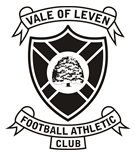
Vale of Leven Football Club is a Scottish football club based in the town of Alexandria, in the Vale of Leven area of West Dunbartonshire. Nicknamed the Vale and formed in 1939, they play at Millburn Park. They play in the West of Scotland League Third Division, the ninth tier of Scottish football.
The 1873–74 Scottish Cup – officially the Scottish Football Association Challenge Cup – was the first season of Scotland's most prestigious football knockout competition. A total of 16 teams from the west of Scotland entered the competition, but only 14 played a match after two teams withdrew. The competition began with a match between Renton and Kilmarnock on 18 October 1873 and concluded with the final on 21 March 1874. After 16 matches and 38 goals, the inaugural cup was won by Queen's Park who defeated fellow Glasgow club Clydesdale 2–0 in the final.

The 1874–75 Scottish Cup – officially the Scottish Football Association Challenge Cup – was the second season of Scotland's most prestigious football knockout competition. Teams from Edinburgh, Renfrewshire and Lanarkshire entered the competition for the first time and with 12 new teams entering the competition, a total of 25 were included in the first round draw. The competition began with the first round match between Rangers and Oxford on 10 October 1874 and concluded with the final on 10 April 1875. After 27 matches and 56 goals scored, defending champions Queen's Park retained the trophy by defeating Dunbartonshire club Renton 3–0 at the original Hampden Park.
Granville Football Club was a short-lived 19th-century football club based at Myrtle Park, in Crosshill, Glasgow.
Dumbreck Football Club was a 19th-century association football club based in Glasgow.
Blythswood Football Club was a 19th-century football club based in Glasgow.

The 1877–78 Scottish Cup – officially the Scottish Football Association Challenge Cup – was the fifth season of Scotland's most prestigious football knockout competition. For the first time, over 100 teams took part in the competition which began with the first round on 22 September 1877. The cup was won by Vale of Leven for a second time after they defeated Glasgow club 3rd Lanark RV 1–0 in the final on 30 March 1878.
Ayr Thistle Football Club was a Scottish football team from the town of Ayr.

The 1878–79 Scottish Cup – officially the Scottish Football Association Challenge Cup – was the sixth season of Scotland's most prestigious football knockout competition. Defending champions Vale of Leven met Rangers in the final but, after a 1–1 draw in the original match on 19 April 1879, the replay was scratched and Vale of Leven were awarded the cup. Rangers objected to a goal being disallowed in the original match and refused to play the replay.
Thornliebank Football Club was a football club that existed between 1875 and 1907, based in Thornliebank, Renfrewshire, Scotland.
The 1874 Scottish Cup final was the inaugural final of the Scottish Cup and the final of the 1873–74 Scottish Cup, the most prestigious knockout football competition in Scotland. The match took place at Hampden Park on 21 March 1874 and was contested by Queen's Park and Clydesdale.

The 1877 Scottish Cup Final was the fourth final of the Scottish Cup and the final of the 1876–77 Scottish Cup, the most prestigious knockout football competition in Scotland. The original match took place at Hamilton Crescent on 17 March 1877 and was contested by Vale of Leven and Rangers. The match was the first final to require two replays to decide a winner.
The 1879 Scottish Cup Final was the sixth final of the Scottish Cup and the final of the 1878–79 Scottish Cup, the most prestigious knockout football competition in Scotland. The match was played at Hampden Park in Crosshill on 19 April 1879 and was watched by a crowd of 6,000 spectators. The final was contested by the defending champions Vale of Leven and Rangers who had never won the cup.
West End Football Club was a Scottish association football club based in Cowlairs, Glasgow.
Kinning Park was a 19th-century sports ground in Kinning Park, Renfrewshire, Scotland, primarily used for cricket and football. It was the home of Clydesdale Cricket Club from 1849, staging a number of important matches against visiting English teams. It was also the original home of the club's football team, Clydesdale F.C. When both teams relocated to Titwood in 1876, Kinning Park was taken over by Rangers F.C., who played there until moving to the first Ibrox Park in 1887. The ground was the venue for the 1881 Scottish Cup Final between Queen's Park and Dumbarton.
Alclutha Football Club was a football club based in Dumbarton, Scotland. From 1883 the club was called Dunbritton Football Club.
Caledonian Football Club, occasionally referred to as Glasgow Caledonian, was a 19th-century association football club based at Kelvinbridge, in Glasgow.
Lennox Football Club was a 19th-century football club based in Dumbarton, in Scotland.
Craig Park Football Club, usually recorded as Craigpark, was a Scottish association football club based in Dennistoun, in Glasgow.
Union Football Club was a 19th-century football club based in Glasgow.



